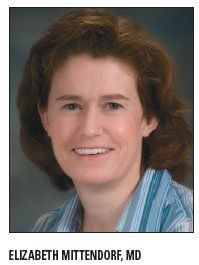Some HER2+ tumors prove resistant to trastuzumab
WASHINGTON-Loss of HER2 positivity is common among women with initially HER2-positive breast cancer who do not have a pathologic complete response (pCR) to neoadjuvant chemotherapy with trastuzumab (Herceptin), according to a report at the ASCO 2008 Breast Cancer Symposium (abstract 150).
ABSTRACT: One-third of breast cancers that do not show a pCR to neoadjuvant chemotherapy plus trastuzumab are no longer HER2-positive.

WASHINGTON-Loss of HER2 positivity is common among women with initially HER2-positive breast cancer who do not have a pathologic complete response (pCR) to neoadjuvant chemotherapy with trastuzumab (Herceptin), according to a report at the ASCO 2008 Breast Cancer Symposium (abstract 150).
“We know that upfront systemic therapy can result in clinical and pathologic responses, which can increase breast conservation rates and, certainly, in those who achieve a pathologic complete response, can predict for improved survival,” said lead investigator Elizabeth A. Mittendorf, MD, of M.D. Anderson Cancer Center. She noted that at M.D. Anderson, combined neoadjuvant chemotherapy and trastuzumab has been associated with pCR rates of about 60%.
Study participants were 143 patients with breast cancers that were HER2-positive, as established by immunohistochemistry and fluorescence in situ hybridization (FISH) performed on biopsy samples. Most of the patients had clinical stage II or III disease.
Between 2004 and 2007, all received neoadjuvant chemotherapy with trastuzumab-12 cycles of weekly paclitaxel with concurrent trastuzumab followed by 4 cycles of fluorouracil, epirubicin, and cyclophosphamide (FEC) with concurrent trastuzumab.
At the time of surgery, 50% of patients were found to have a pCR (absence of any remaining invasive disease in the breast or axilla), Dr. Mittendorf reported. With 10-month follow-up, the recurrence rate was about three times higher among women who did not have a pCR, compared with their counterparts who did (11.3% vs 2.8%).
In the group that did not achieve a pCR, 23 patients had sufficient residual disease after neoadjuvant therapy for HER2 testing by FISH. Seven (30%) of these tumors were no longer HER2-positive. “We were also able to reanalyze their pretreatment biopsy tissue to confirm again using FISH that they were HER2-amplified to begin with,” she noted.
Possible explanations
Dr. Mittendorf proposed two possible explanations for the observed conversions from HER2-positive to HER2-negative status.
“This could represent a treatment effect in that we have selected out the HER2-negative clones: The HER2-positive clones have been treated, and the HER2-negative ones persist,” she said.
Alternatively, she said, “we are hypothesizing that it could represent a possible mechanism of resistance to trastuzumab therapy, and this is something that would require further study in the laboratory.” She noted that re-examination of the tissue has suggested that tumor heterogeneity for HER2 appears to be minimal in the tumors studied, supporting the latter hypothesis. The investigators are now evaluating the tumors for molecular markers that have been implicated in trastuzumab resistance.
Dr. Mittendorf pointed out that retesting tissue after a suboptimal response to neoadjuvant therapy could help guide treatment decisions.
“We believe that consideration should be given to reassessing HER2 status in the residual tumor of patients who do not achieve a pathologic complete response,” she said.
This could identify those patients “who could be enrolled in a clinical trial to further investigate the most appropriate adjuvant therapy in this population.”
Eric Winer, MD, of Harvard Medical School said that it is important to understand mechanisms of resistance in breast cancers in order to develop more effective drugs.
“In this way, cancer medicine is becoming a little bit more like infectious disease medicine, where we know that bacteria become resistant to antibiotics and we develop the next antibiotic [to address that],” he said. “It’s a slightly different approach than we have taken before.”
The fact that the study from which the tissue was obtained began years ago highlights the value of collecting tissue in trials, Dr. Winer noted.
“This [new information] is an unexpected benefit of that initial study, being able to learn something about how HER2 status changes over time,” he said.